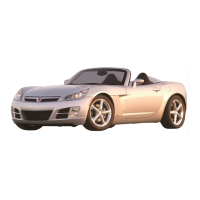The vehicle has Retained Accessory
Power (RAP). With RAP, the audio
system can be played even after the
ignition is turned off. See Retained
Accessory Power (RAP) on
page 2-17 for more information.
Setting the Clock
Radio with Single CD (MP3)
Player
To set the time and date:
1. Turn the ignition key to
ACC/ACCESSORY or ON/RUN.
Press
O to turn the radio on.
2. Press
H and the HR, MIN, MM,
DD, YYYY (hour, minute, month,
day, and year) displays.
3. Press the softkey located below
any one of the tabs that you
want to change.
4. To increase the time or date do
one of the following:
• Press the softkey located
below the selected tab.
• Press ¨SEEK, or \ FWD.
• Turn f clockwise.
5. To decrease the time or date do
one of the following:
• Press ©SEEK or s REV.
• Turn f counterclockwise.
The date does not automatically
display. To see the date press H
while the radio is on. The date with
display times out after a few seconds
and goes back to the normal radio
and time display.
To change the time default setting
from 12 hour to 24 hour or to
change the date default setting from
month/day/year to day/month/year:
1. Press
H and then the softkey
located below the forward arrow
label. Once the time 12H and
24H, and the date MM/DD/YYYY
(month, day, and year) and
DD/MM/YYYY (day, month,
and year) displays.
2. Press the softkey located below
the desired option.
3. Press
H again to apply the
selected default, or let the
screen time out.
Instrument Panel 3-65

